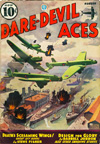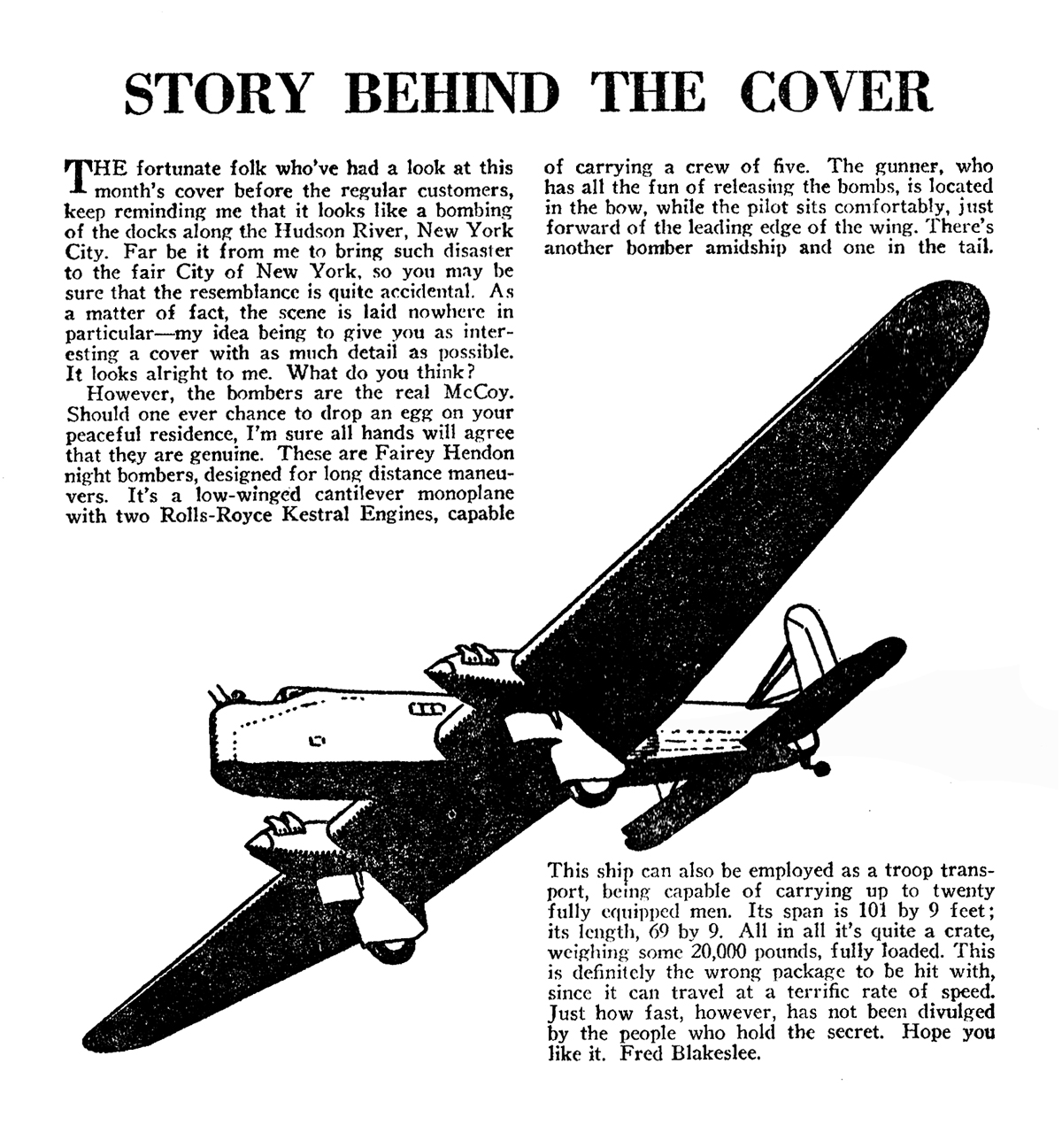AMIDST all the great pulp thrills and features in Sky Fighters, they ran a true story feature collected by Ace Williams wherein famous War Aces would tell actual true accounts of thrilling moments in their fighting lives! This time we have member of the LaFayette Escadrille—Sergeant Kiffin Rockwell!
Kiffin Rockwell was a true soldier 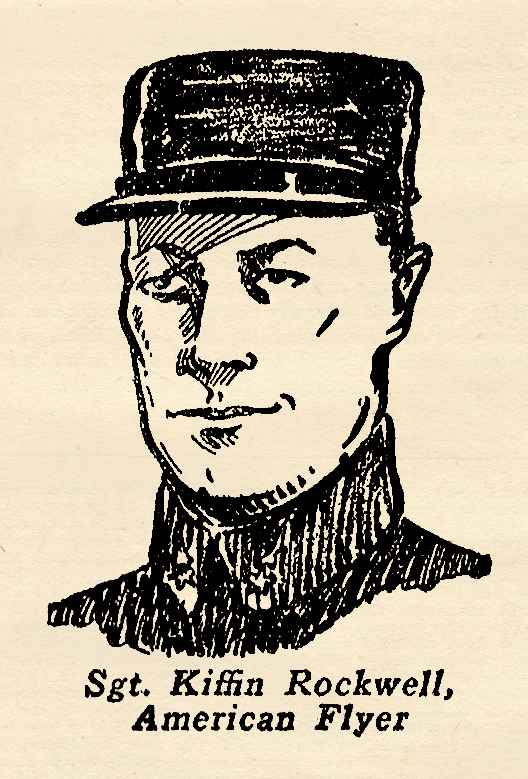 of fortune. Born and raised In Aaheville, N. Carolina, young Rockwell got the wanderlust soon after graduating from the University of Virginia. When the Germans made their surprise move on the forts of Liege, Rockwell was serving in the ranks of the Foreign Legion. For a heroic exploit in hand to hand bayonet fighting, he was awarded the Medaille Militaire. For a whole year he served with the Foreign Legion in the trenches, then transferred to the aviation and went into training at Avord. When Norman Prince formed the first American Flying Squadron in Paris, Rockwell was one of those invited to join. He proved out to be one of the best and most daring pilots of that original band. His career was cut short by his untimely death on September 23rd, 1916.
of fortune. Born and raised In Aaheville, N. Carolina, young Rockwell got the wanderlust soon after graduating from the University of Virginia. When the Germans made their surprise move on the forts of Liege, Rockwell was serving in the ranks of the Foreign Legion. For a heroic exploit in hand to hand bayonet fighting, he was awarded the Medaille Militaire. For a whole year he served with the Foreign Legion in the trenches, then transferred to the aviation and went into training at Avord. When Norman Prince formed the first American Flying Squadron in Paris, Rockwell was one of those invited to join. He proved out to be one of the best and most daring pilots of that original band. His career was cut short by his untimely death on September 23rd, 1916.
Rockwell ran up a score of three official victories before being killed in action and was awarded the Croix de Guerre with additional citation for his Medaille Militaire. The following is taken from a letter to his brother in Asheville.
WHY WE CALL THEM LES BOCHES
by Sergeant Kiffin Rockwell • Sky Fighters, August 1936
YOU asked why we call the Germans les Boches, or butchers, in our language. There are many reasons. I shall relate a recent experience so you can determine for yourself.
Captain Thenault, Prince and I had taken young Balsley out for his second trip over the front. We were cruising along behind the Boche lines when we suddenly found ourselves face to face with about 40 Boches. They were grouped together in a close formation but at different altitudes. On our level there were about 12 or 15 Aviatiks.
These Aviatiks had about the same speed as our Nieuports, but they carried a gunner behind the pilot. The pilot shoots as we do, but the gunner has a movable gun which enables him to fire in all directions.
A Mêlée of Battle
We were but four and on the German side of the lines, but none of us turned and ran away. For ten or fifteen minutes we flew over and around the Aviatiks, being fired at constantly, some of their bursts being at very close range. Finally we saw an opening. One of their machines raced toward our lines. The rest were behind us.
We plunged after this isolated Boche. A general mêlée resulted, for the whole swarm of Boches pounced on us, coming from above and all sides.
One of our planes dived and fell as though streaking to death. I wondered if it were Prince or Balsley. Tough in either case, I thought. Then in the mêlée I lost sight of another of our little Nieuports. Now both Prince and Balsley were gone. Only Captain Thenault and myself remained and the Boches were giving us plenty.
Thenault signalled to draw away and we ran for our lines, confident that both Balsley and Prince had been shot down.
An Exploding Bullet
We managed to run the gauntlet. Later Prince showed up. He had followed down after Balsley when he saw the youngster falling. It appeared that poor Balsley had darted in on a Boche and just as he pressed his Bowden to fire his gun, it jammed.
He swerved off to clear and just at that instant a bullet struck him in the stomach and exploded against his backbone!
Balsley’s machine went into a dive as he fainted over the stick. But the rush of air in the dive revived him. And as he had kept his feet on the rudder he was enabled to redress and land right side up. The machine, however, smashed to bits. Prince got Balsley out. Twelve pieces of the exploded bullet were removed from Balsley’s interior. Balsley will live but he will never fly again.
So, you see why they are called les Boches? This is the second time we have run into explosive bullets. First it was me, and I am not entirely recovered yet, now it is poor Balsley.
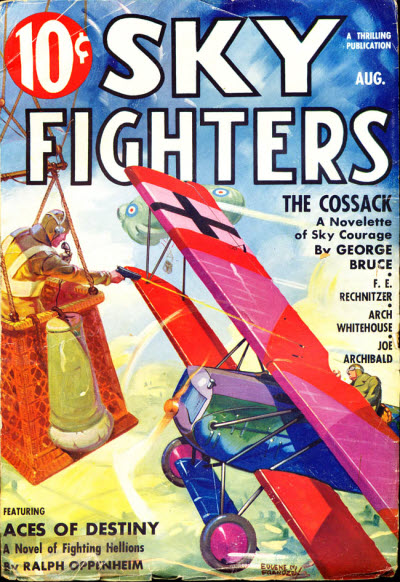 Mosquito Month we have a non-Mosquitoes story from the pen of Ralph Oppenheim. In the mid thirties, Oppenheim wrote a half dozen stories for Sky Fighters featuring Lt. “Streak” Davis. Davis—ace and hellion of the 25th United States Pursuit Squadron—was a fighter, and the speed with which he hurled his plane to the attack, straight and true as an arrow, had won him his soubriquet. Once more it’s a battle against time—B Flight is sent out on a perilous mission to destroy the new Boche anti-tank gun munitions factory by noon in hopes of preventing a massacre when the Allies push forward in their new Whippet tanks. However, after B flight has taken off, Streak learns a spy may have fouled their mission somehow and flies off like a streak to stop them before it’s too late! From the August 1936 issue of Sky Fighters it’s Ralph Oppenheim’s steak Davis in “Aces of Destiny!”
Mosquito Month we have a non-Mosquitoes story from the pen of Ralph Oppenheim. In the mid thirties, Oppenheim wrote a half dozen stories for Sky Fighters featuring Lt. “Streak” Davis. Davis—ace and hellion of the 25th United States Pursuit Squadron—was a fighter, and the speed with which he hurled his plane to the attack, straight and true as an arrow, had won him his soubriquet. Once more it’s a battle against time—B Flight is sent out on a perilous mission to destroy the new Boche anti-tank gun munitions factory by noon in hopes of preventing a massacre when the Allies push forward in their new Whippet tanks. However, after B flight has taken off, Streak learns a spy may have fouled their mission somehow and flies off like a streak to stop them before it’s too late! From the August 1936 issue of Sky Fighters it’s Ralph Oppenheim’s steak Davis in “Aces of Destiny!”







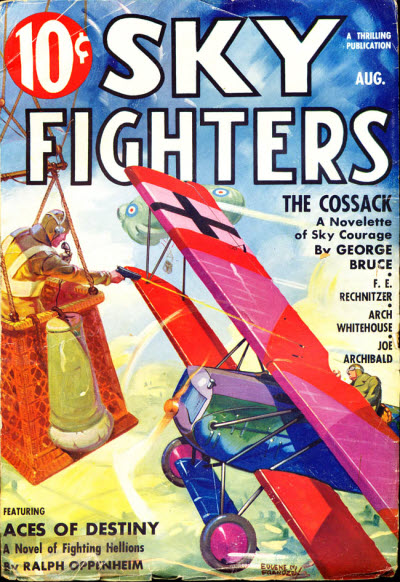 a short, but gripping tale from the prolific pen of
a short, but gripping tale from the prolific pen of 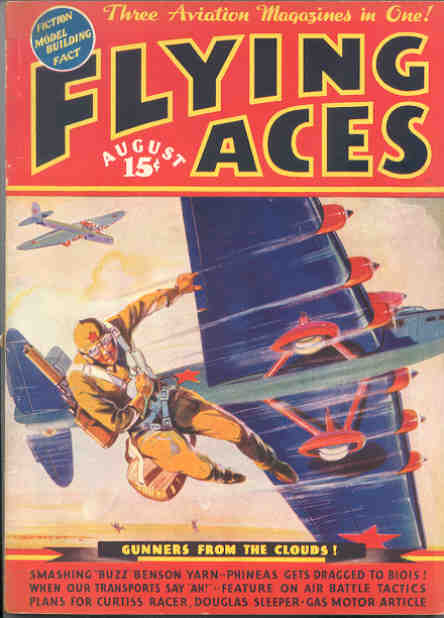 You heard right! That marvel from Boonetown, Iowa is back! This time the skull-duggerian of the Ninth Pursuit Squadron, U.S. Air Force runs afoul of some brass hats and gets busted and sent to Blois—provided they can find him! It’s another sky-high Phineas mirthquake! From the August 1936 Flying Aces, it’s “Blois, Blois, Black Sheep.”
You heard right! That marvel from Boonetown, Iowa is back! This time the skull-duggerian of the Ninth Pursuit Squadron, U.S. Air Force runs afoul of some brass hats and gets busted and sent to Blois—provided they can find him! It’s another sky-high Phineas mirthquake! From the August 1936 Flying Aces, it’s “Blois, Blois, Black Sheep.” of fortune. Born and raised In Aaheville, N. Carolina, young Rockwell got the wanderlust soon after graduating from the University of Virginia. When the Germans made their surprise move on the forts of Liege, Rockwell was serving in the ranks of the Foreign Legion. For a heroic exploit in hand to hand bayonet fighting, he was awarded the Medaille Militaire. For a whole year he served with the Foreign Legion in the trenches, then transferred to the aviation and went into training at Avord. When Norman Prince formed the first American Flying Squadron in Paris, Rockwell was one of those invited to join. He proved out to be one of the best and most daring pilots of that original band. His career was cut short by his untimely death on September 23rd, 1916.
of fortune. Born and raised In Aaheville, N. Carolina, young Rockwell got the wanderlust soon after graduating from the University of Virginia. When the Germans made their surprise move on the forts of Liege, Rockwell was serving in the ranks of the Foreign Legion. For a heroic exploit in hand to hand bayonet fighting, he was awarded the Medaille Militaire. For a whole year he served with the Foreign Legion in the trenches, then transferred to the aviation and went into training at Avord. When Norman Prince formed the first American Flying Squadron in Paris, Rockwell was one of those invited to join. He proved out to be one of the best and most daring pilots of that original band. His career was cut short by his untimely death on September 23rd, 1916.